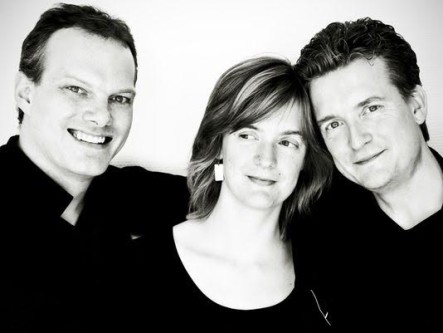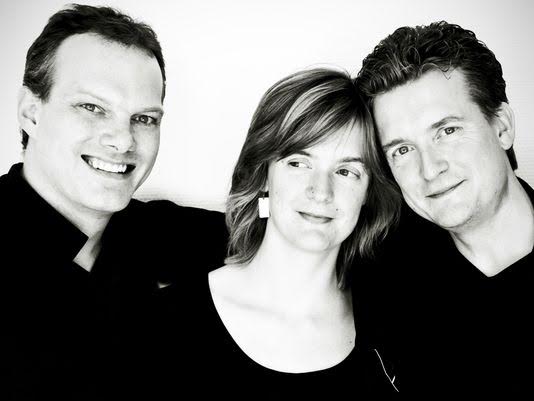 Canada Schumann, Dvořák, Brahms: Tetzlaff Trio (Christian Tetzlaff, violin; Tanja Tetzlaff, cello; Lars Vogt, piano), Chan Centre, Vancouver, 21.2.2016. (GN)
Canada Schumann, Dvořák, Brahms: Tetzlaff Trio (Christian Tetzlaff, violin; Tanja Tetzlaff, cello; Lars Vogt, piano), Chan Centre, Vancouver, 21.2.2016. (GN)

Schumann: Piano Trio No. 2 in F major, Op. 80
Dvořák: Piano Trio No. 4 in E minor, Op. 90 ‘Dumky’
Brahms: Piano Trio No. 1 in B major, Op. 8
Violinist Christian Tetzlaff has given wonderful performances here in previous years, but we had not yet seen him with his admirable allies, cellist/sister Tanja Tetzlaff and esteemed pianist Lars Vogt, who comprise the Tetzlaff Trio. It turned out to be a rather intense experience. This is not an ensemble that spins out an endless stream of amiability and relaxed charm; rather, it leans toward a very tight, clean articulation with little romantic padding, and often pushes the music to dynamic extremes with uncompromising terseness. This in principle suited the dramatic dimensions of the Schumann, Dvořák and Brahms trios although, while intelligence and insight abounded, the playing sometimes tended to the hard, unremitting side, bringing the jagged edges of the compositions out very starkly. This is not always a bad thing, and possibly some of the ‘hardness’ of the projection was due to the acoustics of the Chan Centre, a very large space for a piano trio and not a particularly warm one either. Be that as it may, this outing could hardly help but leave a sharp imprint: musicians of this stature simply can do things that others cannot.
The Schumann Piano Trio No. 2 came off most impressively. One would hardly mention the work as one of the peaks of the composer’s output, but this approach balanced very convincingly its passionate turbulence with its more fragile yearning. I found it very similar to their 2012 Gramophone award-winning recording for EMI, when Leif Ove Andsnes was the pianist. In the opening ‘Sehr lebhaft’, Christian Tetzlaff’s tender, yielding moments had a particular beauty when set against an often tempestuous and frenzied motion. And the same in the following movement, where the violinist found a withdrawn yearning and the ensemble together managed to find an almost improvisational quality in the music. Sharper edges and greater extremes surfaced as we worked towards the end, but the precision and commitment of the playing left no doubt that this was a work of emotional gravity, even taking into account its structural weaknesses and turgidities. While the violinist was obviously the leader of the ensemble, the overall sound was solidly integrated ̶ with everyone contributing ̶ though I noticed less interplay and question and answer between the voices than with some groups. Vogt’s piano had an admirable solidity, and sparkling moments too, and balanced very well overall. Tanja Tetzlaff’s wonderfully clean and tight cello phrasing would have a more splendid presence in the later works.
The performance of Dvořák’s ‘Dumky’ Trio struck me as a something of an experiment, though how one responds to it likely depends on exactly how unique one thinks this piano trio is in Dvořák’s output. Personally, I have always felt that, for all of its dramatic and constructional innovation, the piece still preserves the underlying sense of lyrical repose and natural enthusiasm that permeates the composer’s works in general. The concept of ‘dumka’ constitutes a very specific, introspective feeling of deep melancholy and yearning in Dvořák’s hands. While it may be thought of as a lament (duma), it is still an interiorized feeling in which, most importantly, pain is largely implied, not forcibly felt, and can mix with lighter postures. The Tetzlaff Trio definitely went much further than this, probing the work to find real pain and uncontrolled anger, even a macabre underworld. Accordingly, the performance built as somewhat larger than life, as a burning emotional saga – perhaps akin to the composer’s final tone poems. The textures were incredibly lean and sharp, and this astringency sometimes hinted at the 20th century; at other times, perhaps late Beethoven. The approach was definitely eye-opening, but I was not initially sure whether it clarified the work’s meaning or distorted it.
The brooding intensity was there from the beginning, then the strangely-clipped treatment of the (usually sauntering) descending motive of the main Allegro, carrying the movement forth in a particularly spiky manner. This was more than just the observance of Czech accents! The sense of mystery and quiet intensity advanced in the next movement, pushed to almost a ‘furiant’ by its end. I should emphasize how concentrated and probing some of the soft playing was here and later – and how soft it was. Then, as we moved on, the extreme sharpness in articulation took over, sometimes resulting in almost whiplash attacks. After hearing the clipped, staccato treatment of the delightful fourth dumka, I was wondering where the work’s usual delight was, and started longing for just a glimpse of lightness of spirit and natural lyrical flow. But it was not to be. A vehement attack opened the fifth dumka, followed by a myriad of macabre, razor-sharp emphases, and this set the stage for the finale, which in turn was wound up to the highest pitch of passion, defiance and anger – a truly thrusting saga. Quite remarkable in concept and executed superbly, but it was a little much for me. I felt an element of contrivance by the end: this interpretation created a very dramatic ‘story’ but also succeeded in removing many of the work’s more endearing qualities.
The closing Brahms Trio, Op. 8 also had its controversial features. For one, the opening movement was faster than traditionally, making its argument tighter and closer in feeling to the second trio, Op. 87. Again, the sharpness and cogency of the treatment stood out, as did its Brahmsian fibre, though I missed slightly the innocent unfolding of its long lyrical line at a slower tempo. How ‘innocent’ this work should be is a moot point: this may be Op. 8, but Brahms revised it in his maturity. The enigmatic Scherzo is actually one place where the Tetzlaffs might have probed more: it could have been somewhat more withdrawn, shadowy and will-o-wisp at the start. The lovely Adagio was again terser and leaner in projection than typically, and sensitively negotiated, except for a few moments of overadornment. The finale was a powerful and exciting affair, truly virtuosic in feeling, but the level of drive and projection sometimes overloaded the music, especially towards the end. At least in this acoustic, it is where the playing seemed particularly hard and unremitting.
I obviously have some non-trivial qualifications about these last two performances, but I have to admire the boldness of their conception, whether they worked or not. One thing I thought about while walking away from this concert was just how serious all this playing was. Wouldn’t it be possible for the ensemble to exhibit just a few more moments of relaxed play and charm, and perhaps even show a smile, if only to contrast with their unremitting sharpness of purpose? Interestingly, the other feeling was a sense of amazement: that I had never really seen a piano trio play with quite this conviction.
By the way, ‘hats off’ to Reijo Kiilunen of Ondine for taking the ensemble under its wing and recording their Complete Brahms Trios. Christian Tetzlaff seems to be recording the major violin concertos for Ondine as well (with John Storgårds conducting), the Dvorak concerto being released as I write.
Geoffrey Newman
Previously published in a slightly different form on http://www.vanclassicalmusic.com
